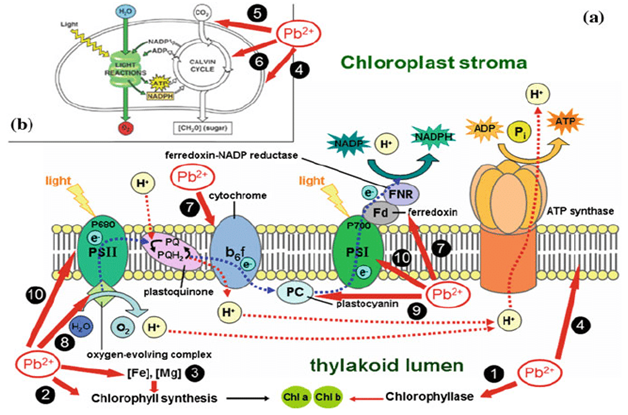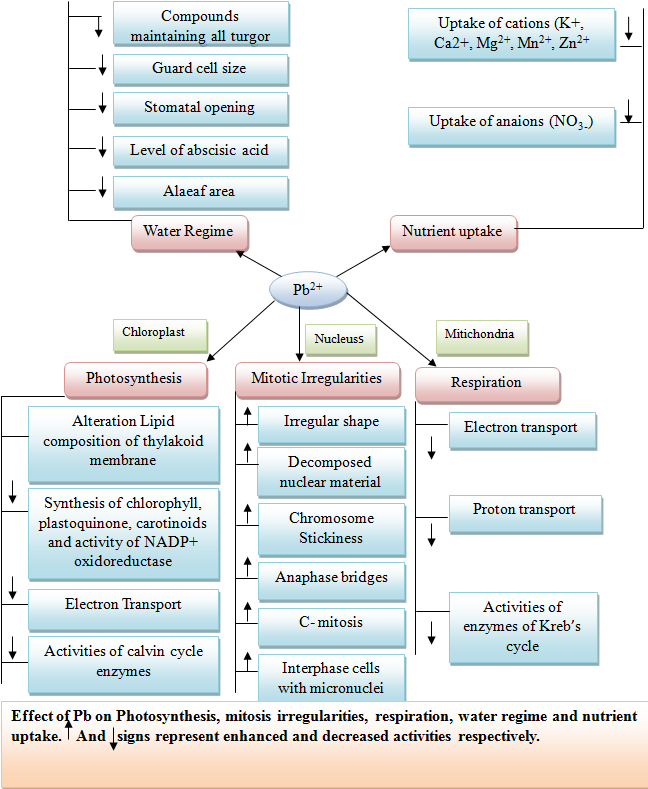Lead effects on Plants

Lead is nondegradable, readily enters the food chain,. Lead is one of the most important environment pollutants and deserves the increasing attention it has received in recent decades. The present effort was undertaken to review lead stress effects on the physiobiochemical activity of higher plants. Lead has gained considerable attention as a potent heavy metal pollutant because of growing anthropogenic pressure on the environment. Lead-contaminated soils show a sharp decline in crop productivity. Lead is absorbed by them mainly through the roots from soil solution and thereby may enter the food chain. The absorption of lead by roots occurs via the apoplastic pathway or via Ca2+-permeable channels.The behavior of lead in soil, and uptake by plants, is controlled by its speciation and by the soil pH, soil particle size, cation-exchange capacity, root surface area,root exudation, and degree of mycorrhizal transpiration. After uptake, lead primarily accumulates in root cells, because of the blockage by Casparian strips within the endodermis. Lead is also trapped by the negative charges that exist on roots' cell walls.Excessive lead accumulation in plant tissue impairs various morphological, physiological, and biochemical functions in plants, either directly or indirectly, and induces a range of deleterious effects.
Source: https://www.ncbi.nlm.nih.gov/pubmed/21541849
Source of lead pollution
Pb is a major pollutant in both terrestrial and aquatic ecosystems. Besides natural weathering processes the main sources of Pb pollution are exhaust fumes of automobiles, chimneys of factories using Pb, effluents from the storage battery, industry, mining and smelting of Pb ores, metal plating and finishing operations, fertilizers, pesticides and additives in pigments and gasoline.
Effects of lead
The visual non-specific symptoms of Pb toxicity are rapid inhibition of root growth, stunted growth of the plant and chlorosis. When Pb enters inside the cells even in small amounts it produces a wide range of adverse effects on physiological processes. A generalized view of the effects of Pb toxicity on key physiological processes in plants. Pb phytotoxicity leads to inhibition of enzyme activities, disturbed mineral nutrition, water imbalance, change in hormonal status and alteration in membrane permeability. These disorders upset normal physiological activities of the plant. At high concentrations Pb eventually may Pb to cell death. At the cellular level Pb inhibits the activities of enzymes containing sulphydryl (-SH) groups necessary for their activity. Pb toxicity inhibits germination of seeds and retards growth of seedlings. Pb decreases germination percent, germination index, root/shoot length, tolerance index and dry mass of roots and shoots. High concentrations of Pb (1 mM) caused 14 to 30 % decreased germination in rice seeds and reduced the growth of seedlings by more than 13 to 45 % . In Lupinus, Pb reduced the number of germinating seeds and caused shortening of hypocotyl as well as roots.

Source: toxicity metal on plants , Braz.j. plant physiology.
Enzymes activities
Pb treatment influences the activity behaviours of a wide range of enzymes of different metabolic pathways. Increasing attention has been paid to understand the action of Pb on plant enzymes. Pb at a concentration of 10-5 to 2 x 10-4 M produces about 50 % inhibition of many enzymes. This concentration is defined as the inactivation constant (Ki). In most, the inhibition exerted by Pb on enzyme activity results from the interaction of Pb with enzyme –SH groups. Pb interacts with free –SH groups that are present in the active site of the enzyme and essential for enzyme activity as well as with –SH groups that are necessary for the stabilization of enzyme tertiary structure. Besides the reaction with –SH groups, blockage of –COOH groups with Pb ions also appears to play a major role in inhibition of enzyme activity under Pb treatment. Pb forms a mercaptide with the –SH group of cysteine and also forms complexes with phosphate groups. Inhibition of metalloenzymes under Pb treatment appears to be due to displacement of the essential metal by Pb. The inhibition of enzyme activity due to Pb does not appear to be specific for Pb, as such inhibitions are also evident with other cations having comparable affinities for protein functional groups.
Source: Toxicity in plants, Pallavi sharma, Banaras hindu university
Lead tolerance in plants
The two basic strategies of metal uptake related to tolerance in plants :
- The 'excluder' strategy in which the concentration of heavy metals is maintained at a constant low level until critical soil concentration is reached when toxicity ensues and unrestricted metal transport results.
- The 'accumulator' strategy in which metals are actively concentrated within the plant tissues over the full range of soil concentration implying a highly specialized physiology. Berry (1986) also suggested three basic strategies of response: avoidance, detoxification and biochemical tolerance each of which affects tissue metal concentrations in different ways.
Photosynthesis
The process of photosynthesis is adversely affected by Pb toxicity.Plants exposed to Pb ions show a decline in photosynthetic rate which results from distorted chloroplast ultrastructure, restrained synthesis of chlorophyll, plastoquinone and carotenoids, obstructed electron transport, inhibited activities of Calvin cycle enzymes, as well as deficiency of CO2 as a result of stomatal closure. Ceratophyllum demersum plants when grown in aquatic medium containing Pb(NO3)2 showed distinct changes in chloroplast fine structure. Leaf cells of such plants exhibited a reduction in grana stacks together with a reduction in the amount of stroma in relation to the lamellar system as well as absence of starch grains. Pb treatment also changes the lipid composition of thylakoid membranes (Stefanov et al., 1995). Effects of Pb on various components of photosynthesis, mitotic irregularities, respiration, water regime and nutrient.

Pb has gained considerable attention as a potent heavy metal pollutant due to the growing anthropogenic pressure on the environment. Pb contaminated soils show a sharp decline in crop productivity. Pb is taken up by plants mainly through the root system and partly, in minor amounts through the leaves. Inside the plants Pb accumulates primarily in the root but a part of it is translocated to the aerial portions. Soil pH, soil particle size, cation exchange capacity as well as plant factors such as root surface area, root exudation and mycorrhizal transpiration rate affect the availability and uptake of lead. Limited translocation of Pb occurs from root to other organs due to the barrier function of the root endodermis. At lethal concentrations this barrier is broken and the flux of Pb enters the vascular tissues. Pb deposits of various size are present mainly in the intercellular spaces, cell walls and vacuoles. Small deposits of this metal are also seen in the endoplasmic reticulum, dictyosome and dictyosome derived vesicles. After entering the cell, Pb inhibits activities of many enzymes, upsets mineral nutrition and water balance, changes the hormonal status and affects membrane structure and its permeability. Visual non-specific symptoms of Pb toxicity are stunted growth, chlorosis and blackening of the root system.
Source: Brazilian Journal of plant physiology, Braz. J.Plant physiology (2005), Toxic metal in plants